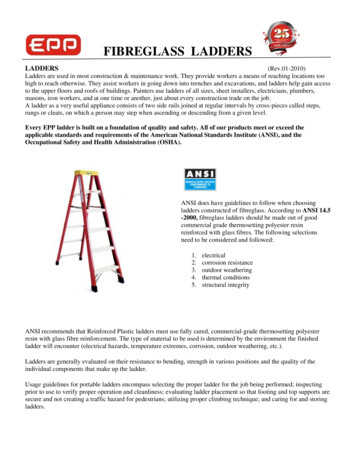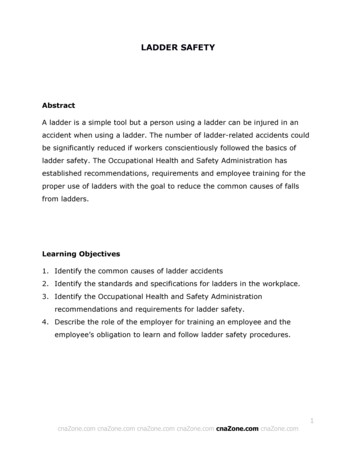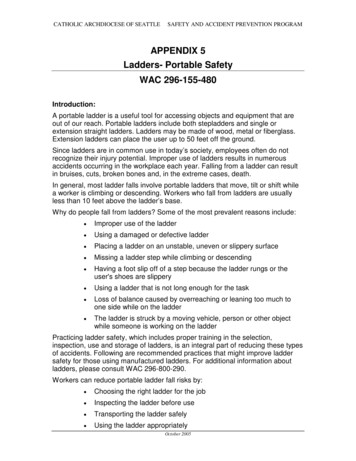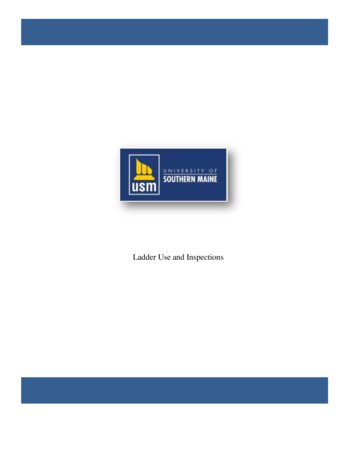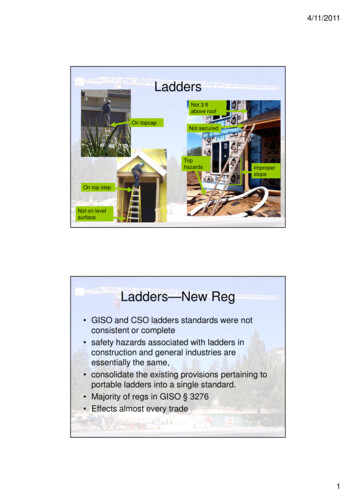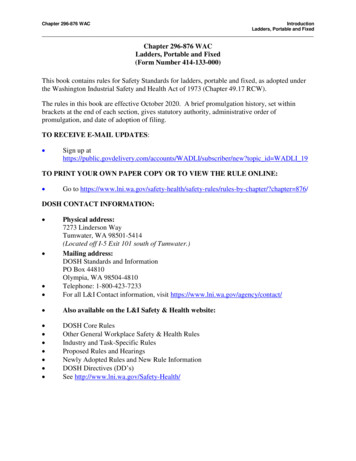
Transcription
Chapter 296-876 WACIntroductionLadders, Portable and FixedChapter 296-876 WACLadders, Portable and Fixed(Form Number 414-133-000)This book contains rules for Safety Standards for ladders, portable and fixed, as adopted underthe Washington Industrial Safety and Health Act of 1973 (Chapter 49.17 RCW).The rules in this book are effective October 2020. A brief promulgation history, set withinbrackets at the end of each section, gives statutory authority, administrative order ofpromulgation, and date of adoption of filing.TO RECEIVE E-MAIL UPDATES: Sign up bscriber/new?topic id WADLI 19TO PRINT YOUR OWN PAPER COPY OR TO VIEW THE RULE ONLINE: Go to rules-by-chapter/?chapter 876/DOSH CONTACT INFORMATION: Physical address:7273 Linderson WayTumwater, WA 98501-5414(Located off I-5 Exit 101 south of Tumwater.)Mailing address:DOSH Standards and InformationPO Box 44810Olympia, WA 98504-4810Telephone: 1-800-423-7233For all L&I Contact information, visit https://www.lni.wa.gov/agency/contact/ Also available on the L&I Safety & Health website: DOSH Core RulesOther General Workplace Safety & Health RulesIndustry and Task-Specific RulesProposed Rules and HearingsNewly Adopted Rules and New Rule InformationDOSH Directives (DD’s)See http://www.lni.wa.gov/Safety-Health/
Chapter 296-876 WACTable of ContentsLadders, Portable and FixedWACPageWAC 296-876-099 Definitions. . 1WAC 296-876-100 Scope. 4WAC 296-876-150 Training. . 5Summary5WAC 296-876-15005 Training. . 5WAC 296-876-200 Design and construction. . 6Summary. 6WAC 296-876-20005 Design and construction. . 6WAC 296-876-300 Ladder care. . 7Summary. 7WAC 296-876-30005 Condition and inspection. . 7WAC 296-876-30010 Repair. . 9WAC 296-876-30015 Storage. . 9WAC 296-876-30020 Transport. . 9WAC 296-876-400 Portable Ladder Use. 10Summary. 10WAC 296-876-40005 Designed use. . 10WAC 296-876-40010 Workplace activities or traffic. . 10WAC 296-876-40015 Support. . 11WAC 296-876-40020 Set-up. . 11WAC 296-876-40025 Climbing and descending. . 12WAC 296-876-40030 Getting on and off ladders at upper levels. . 12WAC 296-876-40035 Exposed electrical hazards. . 13WAC 296-876-40040 Persons on ladders. . 13WAC 296-876-40045 Multisection ladders. . 13WAC 296-876-40050 Self-supporting ladders. . 14WAC 296-876-500 Fixed ladder design and construction installed on or afterDecember 1, 2006. . 15Summary. 15WAC 296-876-50010 Design and construction — Fixed ladders installed on or afterDecember 1, 2006. 15WAC 296-876-600 Fixed ladder design and construction installed beforeDecember 1, 2006. . 16Summary . 16WAC 296-876-60005 Design and construction — Fixed ladders installed beforeDecember 1, 2006. 16WAC 296-876-60010 Design loads. . 17WAC 296-876-60015 Pitch. 17Page i
Chapter 296-876 WACTable of ContentsLadders, Portable and FixedWAC 296-876-60020 Welding. . 18WAC 296-876-60025 Ladder surfaces. . 18WAC 296-876-60030 Rungs, cleats and steps. . 18WAC 296-876-60035 Side rails. . 19WAC 296-876-60040 Clearances. . 19WAC 296-876-60045 Step-across distance. . 21WAC 296-876-60050 Extensions and grab bars. . 21WAC 296-876-60055 Hatches. . 22WAC 296-876-60060 Platforms. . 23WAC 296-876-60065 Protective structures and equipment. . 24WAC 296-876-60070 Cages. . 24WAC 296-876-60075 Wells. . 25WAC 296-876-60080 Ladder safety devices. . 26WAC 296-876-700 Fixed ladders inspection and maintenance. . 27Summary . 27WAC 296-876-70005 Protection against corrosion and deterioration. . 27WAC 296-876-70010 Inspection and repair. . 27WAC 296-876-800 Fixed ladder use. . 29Summary . 29WAC 296-876-80005 Designed load. . 29WAC 296-876-80010 Climbing and descending. . 29WAC 296-876-90005 Step bolt requirments. . 33WAC 296-876-90010 Manhole step requirements. . 34WAC296-876-910 Mobile ladder stands and mobile ladder stand platforms. . 34Summary . 34WAC 296-876-91005 General requirements. . 34WAC 296-876-91010 Design requirements for mobile ladder stands. . 35WAC 296-876-91015 Design requirements for mobile ladder stand platforms. . 35Page ii
Chapter 296-876 WACLadders, Portable and FixedWAC 296-876-099 Definitions.Cage. An enclosure mounted on the side rails of a fixed ladder or fastened to a structure behindthe fixed ladder that the climbing space of a fixed ladder. It may also be called a “cage guard” or“basket guard.”Carrier. The track of a ladder safety system that consists of a flexible cable or rigid railattached, or immediately adjacent, to a fixed ladder.Cleat. See “rung.”Combination ladder. See “special purpose ladder.”Competent person. Is an individual knowledgeable of ladders, including the manufacturer’srecommendations and instructions for the proper use, inspection, and maintenance; and who iscapable of identifying existing and potential ladder hazards; and who has the authority to takeprompt corrective action to eliminate those hazards; and who is knowledgeable of the rulescontained in this part regarding the installation, use, inspection, and maintenance of ladders.Equivalent. Alternative design, material or method to protect against a hazard. You have todemonstrate it provides an equal or greater degree of safety for employees than the method,material or design specified in the rule.Extension ladder. A non-self-supporting portable ladder which is adjustable in length.Failure. The ladder or ladder component loses the ability to carry the load, breaks, or separatesinto component parts.Fastenings. A fastening is a device to attach a ladder to a structure, building, or equipment.Fixed ladder. A ladder permanently attached to a structure, building, or equipment. Fixedladders include individual-rung ladders, but not ship stairs, step bolts or manhole steps.Grab bars. An individual horizontal or vertical handhold installed to provide access above theheight of the ladder.Job-made ladder. A ladder that is made, not commercially manufactured, to fit a specific jobsituation. They are for temporary use until a particular phase of construction is completed oruntil permanent stairways or fixed ladders are ready to use.Individual-rung/step ladder. A fixed ladder consisting of individual steps or rungs mounteddirectly to the side or wall of the structure, building, or equipment. An individual-rung ladderdoes not include manhole steps.Ladder. A device having steps, rungs, or cleats that can be used to climb or descend.Ladder safety device. Any device, other than a cage or well, designed to eliminate or reducethe possibility of falling from a ladder. A ladder safety device usually consists of a carrier,safety sleeve, lanyard, connectors, and body harness.Ladder type. The designation that identifies the maximum intended load (working load) of theladder. Ladder types are as follows:Page 1
Chapter 296-876 WACLadders, Portable and FixedDuty RatingLadderTypeUseMaximum IntendedLoad (pounds)Extra Heavy-DutyIAIndustry, utilities, contractors300Heavy-DutyIIndustry, utilities, contractors250Medium-DutyIIPainters, offices, lightmaintenance225Light-DutyIIIGeneral household use200Landing. Any area such as the ground, roof, or platform that provides access or egress to aladder.Manhole steps. Steps that are individually attached to, or set into, the wall of a manholestructure.Maximum intended load. The total load of all persons, equipment, tools, materials, transmittedloads, and other loads reasonably anticipated to be applied to a ladder or ladder component atany one time. Sometimes referred to as working load.Mobile. Manually propelled or moveable.Mobile ladder stand (ladder stand). A mobile, fixed height, self-supporting ladder that usuallyconsists of wheels or casters on a rigid base and steps leading to a top step. A mobile ladderstands also may have handrails and is designed for use by one employee at a time.Mobile ladder stand platform. A mobile fixed-height, self-supporting unit having one or morestanding platforms that are provided with means of access or egress.Pitch. The included angle between the horizontal and the ladder, measured on the opposite sideof the ladder from the climbing side.Portable ladder. A ladder that can be readily moved or carried.Qualified. Describes a person who, by possession of a recognized degree, certificate, orprofessional standing, or who by extensive knowledge, training, and experience has successfullydemonstrated the ability to solve or resolve problems relating to the subject matter, the work, orthe project.Reinforced plastic. A plastic that has high-strength fillers embedded in the base resin toincrease strength.Reinforced plastic ladder. A ladder whose side rails are reinforced plastic. The crosspieces,hardware, and fasteners may be made of metal or other suitable material.Rung. A ladder crosspiece used in climbing or descending. Also called a cleat or step.Side-step ladder. A fixed ladder that requires an employee to step sideways from the ladder inorder to reach a walking-working surface, such as a landing.Single ladder. A non-self-supporting portable ladder, nonadjustable in length, consisting of onesection. The size is designated by the overall length of the side rail.Single-rail ladder. A portable ladder with crosspieces mounted on a single rail. Single-railladders are prohibited from use.Page 2
Chapter 296-876 WACLadders, Portable and FixedSpecial-purpose ladder. A portable ladder that by design can be used as a stepladder, extensionladder, trestle ladder, stairway ladder, etc., in order to adapt the ladder to special or specific uses.The components of a combination ladder also may be use separately as a single ladder.Step. See “rung.”Stepladder. A self-supporting portable ladder, nonadjustable in length, with flat steps andhinged at the top. The size is designated by the overall length of the ladder measured along thefront edge of the side rails.Step bolt. (Also referred to as “pole step”) means a bolt or rung attached at intervals along astructural member used for foot placement and as a handhold when climbing or standing.Step stool. A self-supporting, portable ladder that has flat steps and side rails. For the purposesof the final rule, stepstools include only those ladders that have a fixed height, so not have a pailshelf, and do not exceed thirty-two inches (81 cm) in overall height to the top cap, although siderails may extend above the top cap. A stepstool is designed so an employee can climb and standon all of the steps and the top cap.Through ladder. A fixed ladder that allows an employee to step between the side rails of theladder to reach a walking-working surface, such as a landing.Trestle ladder. A self-supporting portable ladder, nonadjustable in length, consisting of twosections hinged at the top to form equal angles with the base. The size is designated by thelength of the side rails measured along the front edge.Well. A permanent, complete walled enclosure around a fixed ladder.Working length. The length of a non-self-supporting ladder, measured along the rails, from thebase support point of the ladder to the point of bearing at the top.Page 3
Chapter 296-876 WACLadders, Portable and FixedWAC 296-876-100 Scope.This chapter applies to portable and fixed ladders (including job-made wooden ladders), mobileladder stands, and mobile ladder stand platforms. For fall arrest harness, rope/cable grab, andsimilar requirements related to ladder safety systems which are used on fixed ladders (see theunified fall protection rule, chapter 296-880 WAC).EXEMPTION:This chapter does not apply to:1.2.3.4.5.Portable ladders used by the fire services for fire combat that are covered by SafetyStandards for Firefighters, Chapter 296-305 WAC;Ladders used in other emergency training, and operations like rescue, and tactical lawenforcement,Agriculture activities covered by Safety Standards for Agriculture, Chapter 296-307WAC.Ladders designed into, or is an integral part of machines or equipment;Where noted, “General Industry Only,” these requirements do not yet apply toconstruction chapter 296-155 WAC, maritime chapter 296-56 WAC or shipyardactivities chapter 296-304 WAC.Page 4
Chapter 296-876 WACLadders, Portable and FixedWAC 296-876-150 Training.SummaryYour responsibility: To train employees who use ladders.You must meet the requirements Trainingin this section:WAC 296-876-15005WAC 296-876-15005 Training.(1)You must train employees to recognize ladder hazards and the procedures to minimizethese hazards.(2)You must have a competent person train employees that use ladders in at least thefollowing topics:(3)(a)The proper construction, use, placement, and care in handling ladders.(b)The maximum intended load capacities of ladders that are used.(c)The requirements of this chapter.You must retrain employees as necessary to make sure they know and understand thecontent of the original training.Page 5
Chapter 296-876 WACLadders, Portable and FixedWAC 296-876-200 Design and construction.SummaryYour responsibility: To make sure portable ladders meet design and construction requirements.You must meet the requirements Design and constructionin this section:WAC 296-876-20005WAC 296-876-20005 Design and construction.Important:Design and construction requirements of this section do not apply to specialpurpose ladders.(1)(2)You must make sure portable ladders and job-made wooden ladders manufactured on orafter January 1, 2006, meet the design and construction requirements and specificationsof the appropriate American National Standards Institute (ANSI) standard:(a)ANSI A14.1-2000, American National Standard for Ladders-Portable Wood-SafetyRequirements.(b)ANSI A14.2-2000, American National Standard for Ladders-Portable Metal-SafetyRequirements.(c)ANSI A14.5-2000, American National Standard for Ladders-Portable ReinforcedPlastic-Safety Requirements.(d)ANSI A14.4-2002, American National Standard Safety Requirements for Job-MadeWooden Ladders.You must make sure portable ladders manufactured before January 1, 2006, meet thedesign and construction requirements and specifications of the appropriate ANSI standardin effect on the date of manufacture:(a)ANSI A14.1, American National Standard for Ladders-Portable Wood-SafetyRequirements.(b)ANSI A14.2, American National Standard for Ladders-Portable Metal-SafetyRequirements.(c)ANSI A14.5, American National Standard for Ladders-Portable Reinforced PlasticSafety Requirements.Note: A commercially manufactured portable ladder should have a labelindicating it meets the requirements of the ANSI standard. If in doubt,check with the manufacturer.Page 6
Chapter 296-876 WACLadders, Portable and FixedWAC 296-876-300 Ladder care.SummaryYour responsibility: To make sure portable ladders are inspected, maintained, stored, andtransported properly.You must meet the requirements in this section:Condition and inspectionWAC 296-876-30005RepairWAC 296-876-30010StorageWAC 296-876-30015TransportWAC 296-876-30020WAC 296-876-30005 Condition and inspection.(1)You must keep portable ladders in good, usable condition. Good, usable conditionincludes, but is not limited to:(a)Joints between the steps or rungs and the side rails are tight.(b)Rungs, cleats, or steps are not bent, broken, or missing.(c)Side rails are not bent, broken, or split.(d)All bolts and rivets are in place and secure.(e)Hardware, fittings and accessories are securely attached and working properly.(f)Ropes are not frayed or badly worn.(g)Moveable parts operate freely without binding or excessive play.(h)Safety feet and other auxiliary equipment are not excessively worn.(i)Metal components are not corroded.(j)There are no other faulty or defective components.(k)Rungs and steps of portable metal ladders are corrugated, knurled, dimpled, coatedwith skid-resistant material, or otherwise treated to minimize the possibility ofslipping.(l)Each stepladder or combination ladder used in a stepladder mode is equipped with ametal spreader or locking device that securely holds the front and back sections in anopen position while the ladder is in use.(m) You must maintain portable ladder surfaces free of puncture and laceration hazards.(n)(2)You must ensure portable ladder rungs, steps, and cleats are parallel, level, anduniformly spaced when the ladder is in position for use.You must make sure wood ladders are not coated with an opaque covering except for theminimum amount necessary for identification and warning information which may beplaced on one face only of a side rail.Page 7
Chapter 296-876 WACLadders, Portable and Fixed(3)(4)You must have employees inspect portable ladders, as follows:(a)Competent person when required by Table 1, Ladder Inspection Criteria; and(b)Trained ladder user, prior to the user's initial use in each shift, and as necessaryduring the use to identify defects or damage that may occur during a work shift afterthe initial check. For example, if a ladder tips over, falls off a structure (e.g., roof) orvehicle, is struck by an object (e.g., vehicle or machine), or used in a corrosiveenvironment, evidence of this damage would necessitate the authorized ladder user toinitiate a ladder competent person inspection to determine whether the ladder is stillsafe to use.You must make sure any ladder with structural damage or other hazardous defect is:(a)Marked to identify it as defective or tagged with "do not use" or similar language;and(b)Removed from service.Note: Ladders subjected to certain acids or alkali materials may experiencechemical corrosion and a reduction in strength. Consult themanufacturer or a qualified person prior to use.Table 1 Ladder Inspection CriteriaWhen the ladder is:Do the following:First placed into serviceas necessary while inserviceInspect the ladder for visible defects, including, butnot limited to:1. Working parts; and2. Rung or step connections to the side rails.Damaged by impact ortips over1. Visually inspect the ladder for dents, bends,cracks or splits2. Check:a. Rung or step connections to the side rails.b. Hardware connections.c. Rivets for shear damage.d. All other components.Exposed to excessiveheat such as a fire1. Visually inspect the ladder for damage.2. Test for deflection and strength characteristicsusing the “in-service use tests” contained in theappropriate ANSI standard.EXEMPTION:Job-made wooden ladders are not to be subjected toload or impact tests. Those tests may weakenlumber components or fasteners, causing hiddendamage that could result in sudden failure duringuse.Page 8
Chapter 296-876 WACLadders, Portable and Fixed(5)You must ensure stepstools have a minimum clear width of ten and one-half inches (26.7cm).(6)You must ensure portable ladder rungs, steps, and cleats have a minimum clear width ofeleven and one-half inches (29 cm).EXEMPTION:The minimum clear width does not apply to ladders with narrow rungs that arenot designed to be stepped on, such as those located on the tapered end oforchard ladders and similar laddersWAC 296-876-30010 Repair.(1)You must make sure repairs restore the ladder to a condition meeting its original designcriteria.(2)You must prohibit repairs to a defective side rail.Note: A commercially manufactured ladder with a defective side rail cannotbe repaired by the user. Side rail repair can only be done by themanufacturer.WAC 296-876-30015 Storage.You must make sure material is not put on ladders in storage.Note: Store portable ladders on racks designed to protect them when not inuse. The racks should have enough supporting points to prevent theladder from sagging. Do not store wood ladders near sources of heat,moisture, or dampness.WAC 296-876-30020 Transport.(1)You must properly support ladders while transporting them on vehicles.(2)You must make sure ladders transported in a truck rack are positively secured in a fixedposition that prevents chafing or abrasion.Note: Securing the ladder to each support point will greatly reduce damagedue to road shock.Page 9
Chapter 296-876 WACLadders, Portable and FixedWAC 296-876-400 Portable Ladder Use.SummaryYour responsibility: To use portable ladders safely.You must meet the requirements in this section:Designed useWAC 296-876-40005Workplace activities or trafficWAC 296-876-40010SupportWAC 296-876-40015Set-upWAC 296-876-40020Climbing and descendingWAC 296-876-40025Getting on and off ladders at upper levelsWAC 296-876-40030Exposed electrical hazardsWAC 296-876-40035Persons on laddersWAC 296-876-40040Multisection laddersWAC 296-876-40045Self-supporting laddersWAC 296-876-40050WAC 296-876-40005 Designed use.(1)You must use ladders only for their intended purpose.Note: Unless specifically recommended by the manufacturer, do not use aladder as a:1.2.3.4.(2)Brace.Skid.Lever.Guy or gin pole.5.6.7.8.Gangway.Platform.Scaffold plank.Material hoist.You must make sure not to overload ladders. Do not exceed either the:(a)Maximum intended load; or(b)Manufacturer's rated capacity.WAC 296-876-40010 Workplace activities or traffic.(1)You must protect ladders that are set up in a location where they could be displaced byworkplace activities or traffic by either:(a)Securing the ladder to prevent accidental displacement; or(b)Using a barricade to keep the activities or traffic away from the ladder.Page 10
Chapter 296-876 WACLadders, Portable and Fixed(2)You must protect ladders that are set up in front of doors that open towards the ladder bydoing at least one of the following:(a)Block the door open.(b)Lock the door.(c)Guard the door to keep it from opening into the ladder.WAC 296-876-40015 Support.(1)(2)You must place the ladder either:(a)With a secure footing on a firm, level support surface; or(b)Secure the ladder to prevent accidental displacement.You must make sure a ladder is not placed on ice, snow, or other slippery surface unlessthe ladder is prevented from accidental displacement by either:(a)Securing it; or(b)Providing the ladder with slip-resistant feet.Note: Slip-resistant feet are not a substitute for care in placing, lashing, orholding a ladder that is used on a slippery surface.(3)You must make sure ladders are not placed on boxes, barrels, or other unstable bases toobtain additional height.(4)You must place a straight ladder so the side rails are equally supported by the top support,unless the ladder is equipped with a single support attachment.(5)You must make sure the top support of the ladder is reasonably rigid and able to supportthe load.WAC 296-876-40020 Set-up.(1)You must set up non-self-supporting ladders at a safe angle. The ladder is set at the properangle when the horizontal distance from the top support to the foot of the ladder isapproximately one-fourth the working length of the ladder.(2)You must set up job-made ladders with spliced side rails so that the horizontal distancefrom the top support to the foot of the ladder is not greater than 1/8 the working length ofthe ladder.(3)You must set up the top of a nonself-supporting ladder so that both side rails are supported,unless the ladder is equipped with a single support attachment.Page 11
Chapter 296-876 WACLadders, Portable and FixedWAC 296-876-40025 Climbing and descending.(1)You must have employees use at least one hand to grasp the ladder when climbing up anddown it.(2)You must face the ladder when climbing or descending.(3)You must keep ladders free of oil, grease, or other slippery materials.(4)You must keep the area around the top and bottom of ladders clear.(5)You must make sure single-rail ladders are not used.(6)You must make sure no employee carries any object or load that could cause the employeeto lose balance and fall while climbing up or down the ladder.WAC 296-876-40030 Getting on and off ladders at upper levels.(1)You must make sure a ladder used to access an upper level has the side rails extended atleast 3 feet (0.9 m) above the landing surface if the ladder length permits.(2)You must do the following if a ladder used to access an upper level is not long enough toobtain a 3-foot side rail extension above the landing surface:(a)Secure the ladder at the top to a rigid support that will not deflect.(b)Provide a grasping device, such as a grab-rail, to assist in mounting and dismountingthe ladder.(c)Make sure the ladder deflection under a load would not, by itself, cause it to slip offits support.Page 12
Chapter 296-876 WACLadders, Portable and Fixed(3)You must make sure, if two or more separate ladders are used to reach an elevated workarea, that the ladders are offset with a platform or landing between them.EXEMPTION:A platform or landing is not required when a portable ladder is used to reach afixed ladder on structures such as utility towers and billboards where thebottom of the fixed ladder is elevated to limit access.WAC 296-876-40035 Exposed electrical hazards.You must use ladders with nonconductive side rails where the ladder could contact uninsulated,energized electric lines or equipment. Metal ladders or other ladders specifically designed topermit grounding or dissipation of static electricity may be used around high-static electricalfields if all of the following are met:(1)Using nonconductive ladders would present a greater hazard than using conductive ladders.(2)Ladders are prominently marked and identified as being conductive.(3)Ladders are grounded when used near energized lines or equipment.Note: Examples of ladders with conductive side rails are metal ladders, andwood or reinforced plastic ladders with metal side rail reinforcement.WAC 296-876-40040 Persons on ladders.(1)You must make sure a ladder is not moved, shifted, or adjusted while anyone is on it.(2)You must secure the ladder at the to
Ladders, Portable and Fixed _ Chapter 296-876 WAC Ladders, Portable and Fixed (Form Number 414-133-000) This book contains rules for Safety Standards for ladders, portable and fixed, as adopted under the Washington Industrial Safety and Health Act of 1973 (Chapter 49.17 RCW). The rules in this book are effective October 2020.
